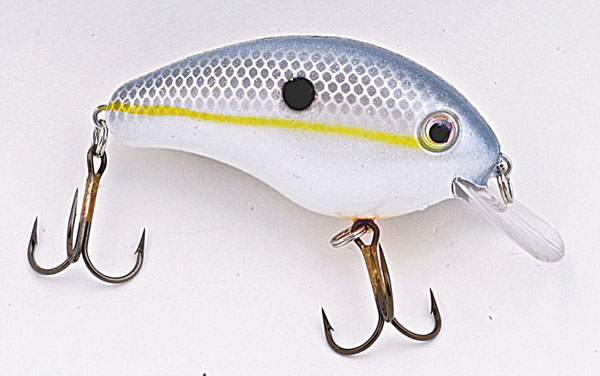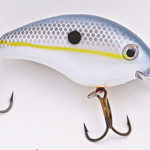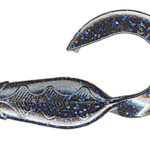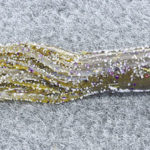
Delacroix trout, reds, flounder still active on inside
The bass fishing on the Red River in Alexandria generally will start turning on in June, depending on the water level. The river still may be flooded this month, but under stable or falling conditions, a number of the bass will begin moving out to the remaining part of the river. In June, I prefer to run to the cuts and the riprap out on the main river and catch the bass on a crankbait or flip wood in the main river.
Strike King Premier Plus spinnerbait
My first lure choice will be the Strike King Premier Plus spinnerbait with two gold Colorado blades and a white/chartreuse skirt to fish visible cover on the main river. I’ll fish with 20-pound-test Cajun Fluorocarbon Line on a Quantum Smoke PT 6.3:1 gear-ratio reel.
Most of the time I’ll be fishing the spinnerbait out of sight after taking off the two Colorado blades and replacing them with one bigger blade to get more thump as the blade spins. If the water is really dirty, I’ll take off both blades and only use a No. 4 or 5 Colorado blade. I want more vibration when I’m fishing dirty water because I want the bass to feel the bait, even if they can’t see it.
The spinnerbait is a relatively weedless bait. I’ll crash it into visible cover, so that it hits the limbs. Generally the main part of the Red River will have current during June, so the bass will be tucked-in tight to that cover. I’ll also slow-roll the spinnerbait along the jetties.
When I come across a log in the water on the jetties or the bank, I’ll pitch the lure into the downstream side of that log or tree and crawl it down the side of the log by slow-rolling it. In a strong current, I’ll fish the spinnerbait on the downstream side of the log. However, in a slight current, I’ll fish it on the front side of the log where the bass will concentrate.
I’ll thread the Strike King Rage Eeliminator as a trailer on the spinnerbait to keep the bait lifted up off the bottom. The Rage Eeliminator has a short, bulky body, but the tail has a slow, wide action. I also use the Rage Eeliminator when I’m fishing the Strike King Pure Poison.
I tried this combo at the 2010 BASS Elite Series tournament in the California Delta, and finished third, so I started fishing it on the Red River. The Rage Eeliminator gives your spinnerbait a bigger profile as it comes through the water and helps raise the bait up off the bottom, so you can fish it shallow. My favorite color of Eeliminator is pearl.
Series 4S Crankbait
Another lure I’ll have tied on is the Strike King Series 4S crankbait that runs about 3 feet deep and features a wide wobble and an extra-loud rattle. My favorite color is chartreuse/black. The 4S isn’t as weedless as the spinnerbait, but it’s pretty close. I can beat up this crankbait on those logs in dirty water and on the riprap, and generate bass bites.
To get quality strikes on a crankbait, you need the right rod. You can’t work a crankbait through cover by not using a really sensitive rod or one that loads up fast, since every time the crankbait touches a piece of wood you can’t see, you’ll set the hook and hang up the crankbait. I use a 7-foot Quantum Energy PT rod, which is constructed of glass and graphite, because I don’t want a total-graphite rod when I’m fishing a crankbait.
With the glass in the rod, I won’t jerk to set the hook as quickly and get the crankbait hung up. When a bass actually bites the crankbait, this rod is slower-reacting, so I don’t feel the bite as quickly, and the bass has longer to engulf the bait before I set the hook. I won’t pull the lure away from the bass as quickly with this type of rod either.
If you’ll pay attention to your line, you’ll feel it drag over the wood before the lure reaches the wood. I slow down my retrieve, so I can crawl the 4S over the wood. Once I crawl the crankbait over a limb, I speed up my retrieve, as if the bait has hit the limb, bounced off it and sped up its escape. The 4S, one of the most-weedless crankbaits on the market, comes through cover well and hunts center, which means the bait will deflect off a limb, maybe to the left, and then return to the center of the retrieve.
The 4S has an aggressive action, and in June, when the bass return to the river after they’ve finished spawning in the backwaters, they’re hungry and want a bait that runs erratically like the 4S. I only use fluorocarbon line when I’m fishing crankbaits, never monofilament line. Besides chartreuse/black, I like solid pearl, a color that also looks good in dirty water.
I take bass with coffee
My third lure of choice for June on the Red River will be the 4-1/2-inch Strike King Coffee Tube in black neon. I like this tube’s coffee scent, and that I can add a Strike King Tube Rattler to it. I’ll either use a 3/8- or a 1/2-ounce Strike King Tour Grade Tungsten weight, unless the current is really heavy. Generally, even if the current’s running strong, if I use a 1/2-ounce weight, I still can get the tube in behind the structure and fish it back to the boat without it getting blown away from the structure.
I prefer to put a rattle in my tube when I’m fishing dirty water, because I want the bass not only to see the tube but also hear the rattle. I may use green pumpkin/blue tail or green pumpkin/chartreuse tail. I’ll be fishing this tube on 50-pound-test braided line and flipping it around any type of structure I can see in the water. I’ll search for rock jetties with logs from spring floods hung up on the rocks to locate concentrated bass.
Most of the bass you catch out on the river will be from 1 to 3 pounds each in June. If you catch a 5-pounder, consider it a giant. When the conditions on the river are good, you can catch 20 to 30 bass in a day of fishing, and on a really good day, you can catch and release 50 bass. You’ll have a mixed bag with spotted bass and largemouth bass.
I know everyone likes to fish the backwaters. However, when the river conditions are good with a little current, you’ll catch more bass out on the river than you will out on the backwater, even though the river bass may not be as big as the backwater bass. Most locals will fish the backwaters, so the least amount of fishing pressure often will be on the main Red River. Even if the backwaters aren’t producing, most anglers will stay in the backwaters. But I’ll be out on the main Red River this month.





